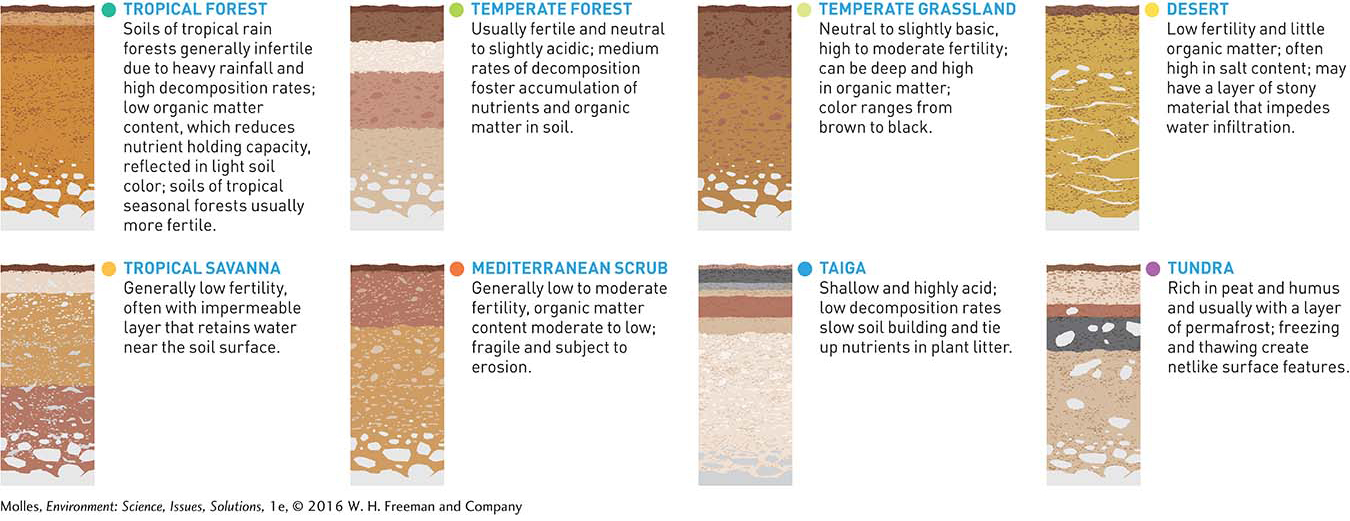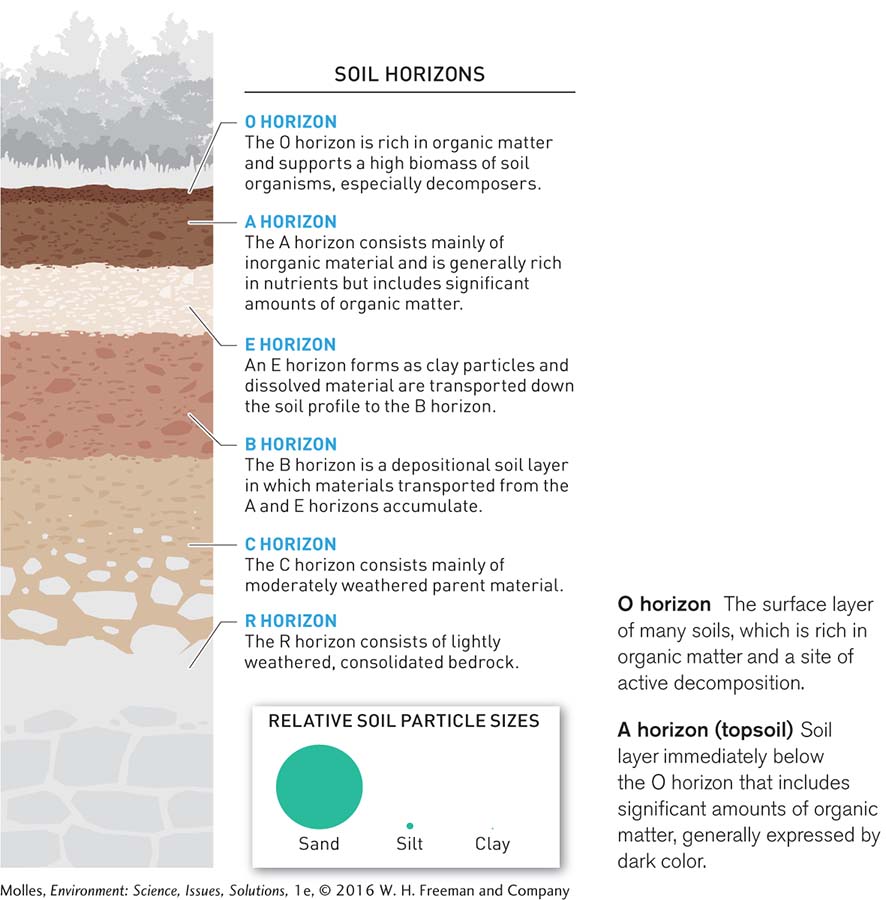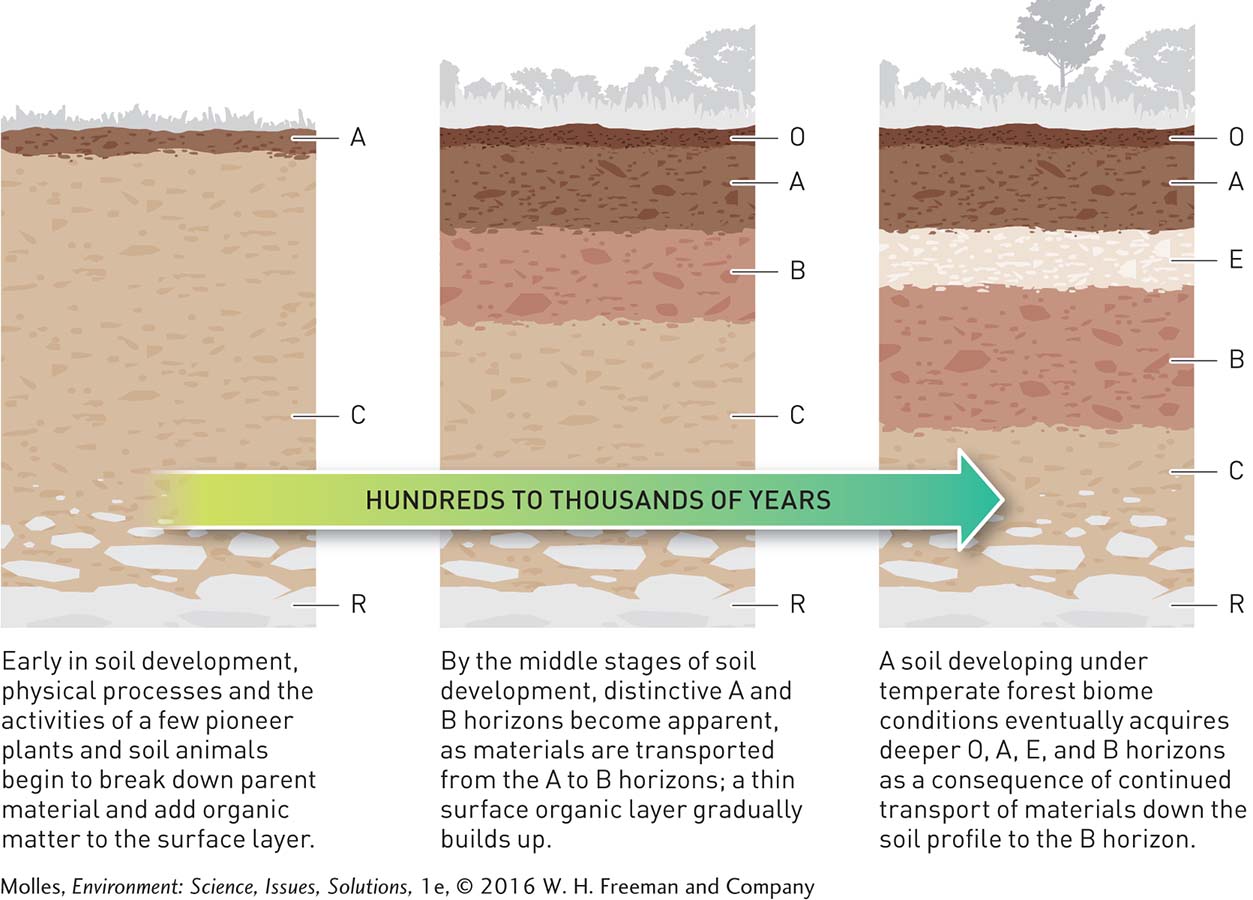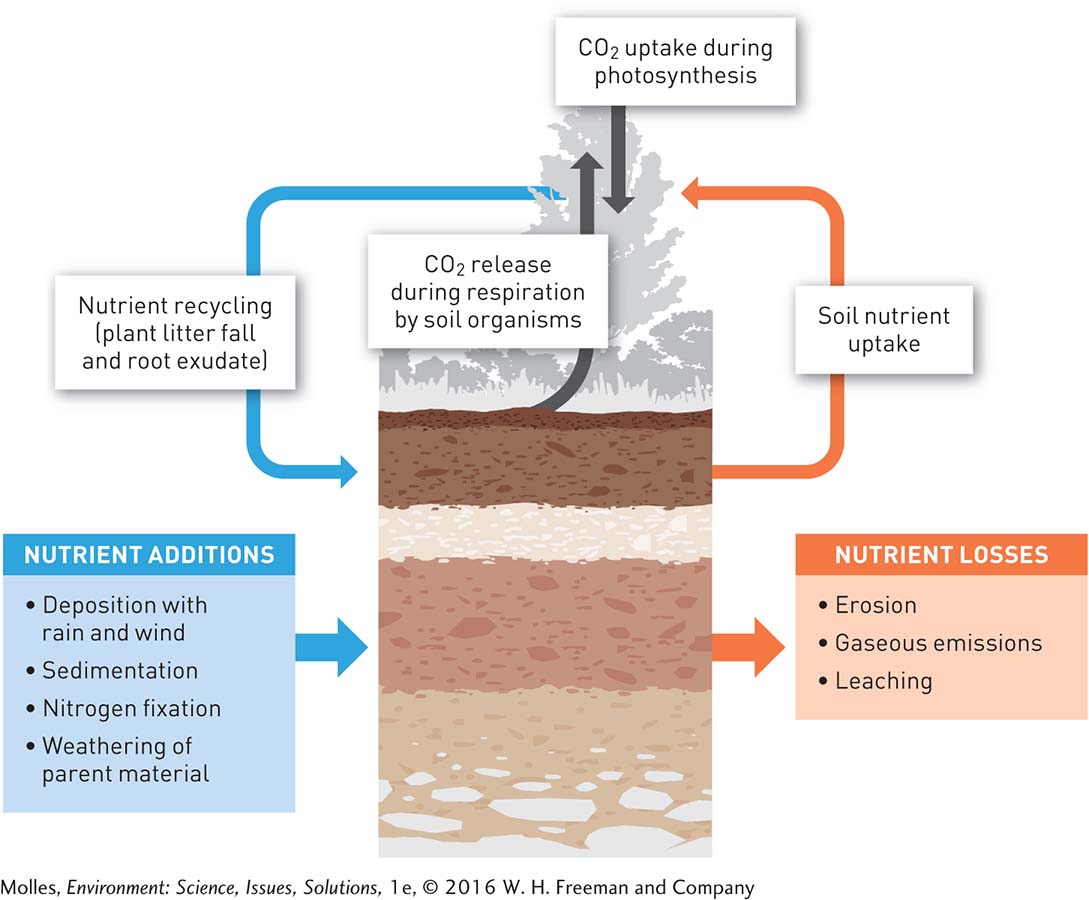7.3 Soil structure and fertility result from dynamic processes
Soils are more than just dirt. Plants depend on them for physical support, water, and nutrients. They are also home to diverse underground organisms. Creatures living in soils range from microscopic bacteria to the largest organism known—


Soil Structure
O horizon The surface layer of many soils, which is rich in organic matter and a site of active decomposition.
If you were to dig into a mature soil, you would find a series of layers, called soil horizons. In a temperate deciduous forest, these are known as the O, A, E, B, C, and R horizons (Figure 7.7).

The surface layer, or the O horizon, is a site of active decomposition of organic matter, such as leaves, twigs, and bark. Burrowing organisms and physical processes, such as freezing and thawing, mix this decomposing organic matter with the inorganic clays and sands found in the lower soil horizons, producing the crumblike structure characteristic of many fertile soils.
A horizon (topsoil) Soil layer immediately below the O horizon that includes significant amounts of organic matter, generally expressed by dark color.
The A horizon, which sits beneath the the O horizon, is typically referred to as the topsoil. It is rich in essential plant nutrients, such as nitrogen, phosphorus, and potassium, on which much plant production is dependent. Although it contains significant amounts of organic matter, which is generally dark in color, the A horizon is predominantly an inorganic layer, consisting of a mixture of various proportions of sand, silt, and clay.

Why are soils with a deep A horizon generally considered good for farming?
soil texture The relative fineness or coarseness of a soil, which is determined by its proportions of sand, silt, and clay.
loam A soil consisting of approximately equal proportions of sand, silt, and clay.
The proportions of sand (coarse and gritty), silt (intermediate grain size), and clay (small grain size) in the topsoil determine soil texture. Soils dominated by one of the three types of mineral soil particles are called sandy, silty, or clay soils. Meanwhile, a soil consisting of approximately equal proportions of sand, silt, and clay is a loam. A loam soil, which has properties intermediate between sandy and clay soils, is considered one of the most desirable for agriculture.
E horizon Soil layer between the A and B horizons, from which clays and dissolved materials are transported down the soil profile to the underlying B horizon.
B horizon A depositional soil layer in which materials transported from the A and E horizons accumulate.
C horizon The deepest soil layer, consisting mainly of lightly weathered parent material.
parent material The bedrock or unconsolidated deposits, such as windblown sand or silt, from which soil develops.
R horizon The base of a soil profile composed of consolidated bedrock, immediately below the C horizon.
In well-
Soil Development
Soil forms as the environment interacts with parent material. The factors important to soil formation include climate, organisms, the nature of the parent material, the topography (or form) of the land surface, and time (Figure 7.8).

Climate directly influences soil development through temperature and precipitation. Temperature fluctuations, freezing and thawing in cold climates, and heating and cooling in hot climates, promote weathering of rocks. Weathering begins with fracturing and fragmentation of large rock, which eventually reduces even great rock formations to small soil particles. The rate of soil development reaches maximum levels in the warm, humid tropics. Climate also indirectly affects soil development through its influences on the activity of soil organisms and plant roots.
erosion A process that removes geologic materials, ranging from clay-
Wind and rain add nutrients as they deposit dust on a landscape (Figure 7.9). Nitrogen-

Though all soils are subject to erosion by wind or water, those on steep slopes are more vulnerable. As soils erode from higher ground, the soil remaining on the slopes is thin and prone to drying. Soils washed into valleys and other low points in a landscape, such as swales, cause a thickening and moistening in these depositional areas.
Think About It
Why might some plants grow well on soils in the early stages of development but not in later stages (see Figure 7.8)?
What properties might lead farmers to consider loam to be an ideal soil?
How would differences in the main factors influencing soil development (climate, organisms, parent material, topography, and time) influence the store of nutrients and organic matter in soils as depicted in Figure 7.9?
If global climate changes such that the optimal zone for grain production moves far to the north, how might soils limit agriculture in this new “climatically optimal” zone?
7.1–7.3 Science: Summary
Climate, which includes temperature and precipitation, is one of the most important factors influencing the amount of biomass an ecosystem produces. Careful experimental research has revealed that biodiversity also has a significant positive influence on productivity, independent of climate. These documented relationships may help in the design of sustainable agricultural systems.
Different climatic conditions support a wide range of biomass production and different soil types. This variation in climate and soils is linked to Earth’s terrestrial biomes, within which human populations have developed systems of farming, ranching, and forestry to harvest primary production for human use.
In a mature temperate deciduous forest, soils have a distinct sequence of layers called the O, A, E, B, C, and R horizons. The main factors important to soil formation include climate, organisms, the nature of the parent material, the topography (or form) of the land surface, and time. The supply of essential plant nutrients (e.g., nitrogen and phosphorus) and organic matter in soils is not static, but rather the result of a dynamic interaction between several processes, such as erosion, deposition, and decomposition.